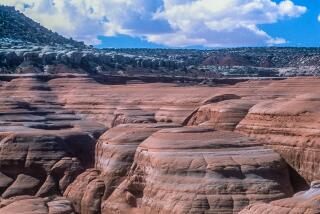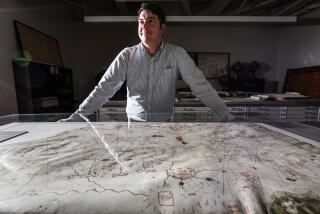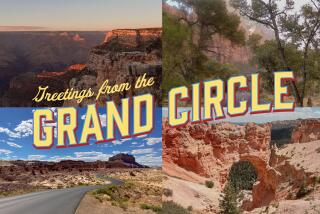Sites Not Worth the Trip
- Share via
Sometimes you just need a little direction.
So before taking off on a summer vacation, make sure you know how to get there. Web sites such as MapBlast (https://www.mapblast.com) and MapQuest (https://www.mapquest.com) offer online driving directions, but many others still sell traditional travel maps.
Finding your way to the right map online, though, might be just as circuitous as your road trip.
To test the quality of both urban and rural maps, I purchased maps of the Grand Canyon and New York City from three Web sites: Maps.com, National Geographic and the U.S. Geological Survey. But online reproductions, if available at all, are illegible, making it impossible to tell what the maps cover before you purchase them. And money spent on shipping, which was sometimes more than the cost of the actual maps, might have been better spent on gas.
Of the sites I visited, Maps.com (https://www.maps.com) boasts the widest variety, including satellite maps, wall maps and digital map graphics. Searchable by collection, the site also offers a keyword search. Simply submit a location and receive a listing of the maps available.
In this case, there were 19 of New York City, 12 of the Grand Canyon. Of those, less than half were travel maps actually designed to lead you down city streets or hiking trails.
For each map, the site provides a short write-up, detailing size and format. Some descriptions even include photographs of the front, back, cover and legend. But they were useless given their presentation. The scanned images are not to size, making them impossible to read.
Without much information on which to base my selection, I decided against the cheap paper maps and the more expensive National Geographic ones. That left me with laminated Rand McNally maps, $6.95 each. Three-day shipping added $9.95, bringing the total cost to $25.52, including tax.
After that pricey purchase, I visited the National Geographic Web site, at https://www.nationalgeographic.com/maps, hoping the maps were cheaper there. They weren’t. However, with a flat U.S. Postal Service shipping fee, I bought the Geographic maps for only 42 cents more than the Maps.com purchase.
Although the selection is limited to National Geographic’s own trail, travel and topographic maps that primarily feature popular vacation destinations, the site includes an interactive “map machine” that generates satellite images of almost any place in the world. So I couldn’t find a map for my grandmother’s hometown--Cherry, Ill., population 500--but the map machine produced a photograph from several thousand feet in the air.
After playing with that and some of the other educational features (including an online atlas that details 191 countries), I ordered a map of New York City for $8.99 and one of the Grand Canyon for $9.95 that supposedly highlighted hiking routes and recreational areas. I couldn’t tell before buying because the site did not offer an online reproduction.
The total cost for the maps, including $7 for taxes and shipping, came to $25.94.
Having purchased enough street and trail maps, I decided to check out U.S. Geological Survey maps at https://www.usgs.gov. With more than two dozen links on the home page, it was not immediately obvious which one would take me to the online order form. After a few failed attempts, I located a “mapfinder” link halfway down the page and submitted my queries.
The site offered only one map for the Grand Canyon, but New York City was split into several, each focusing on a different area of the metropolis. I chose the map of Central Park and ordered it with the Grand Canyon map for only $13, including shipping.
The cheaper price, however, might have been reflective of the longer shipping time. It took more than a week for the maps to arrive.
Despite the extra charge for three-day shipping from Maps.com, I received both my Rand McNally and National Geographic purchases in three days. (According to the Maps.com Web site, only orders placed by 9 a.m. PST, Monday through Friday, are processed the same day. Orders placed on Saturday and Sunday are not processed until the next business day.)
Though the maps were adequate for their purpose, they were not worth the steep shipping fees, which were almost as much--and sometimes more--than the maps themselves.
Both Rand McNally maps were only 19 inches by 17 inches--easy to handle but difficult to read. Although the main New York map covered Manhattan, some parts of Queens, the Bronx and northern Brooklyn, it did not even include the Statue of Liberty.
The National Geographic New York map, at 24 1/2 inches by 18 inches, plotted the city in a little more detail, though it featured only Manhattan. In addition to the main map, it also highlighted points of interest in Midtown and the Financial District and included subway and airport maps.
Based on USGS topographic maps, the National Geographic Grand Canyon map (37 inches by 25 inches) included markings for paved roads, four-wheel-drive roads, hiking trails and ranger stations. It even listed closed or restricted areas in the park as well as campgrounds.
In comparison, the Rand McNally map was virtually useless. Though it highlighted various buttes, rivers and picnic areas, it did not include many roads or hiking trails. And unlike the National Geographic map, which was shaded to reflect elevation, the Rand McNally map was virtually all one color. I had no idea what I was looking at.
Maps.com, fortunately, accepts returns within 10 days of purchase.
Depending upon the map, you still might need direction after all.
*
Christine Frey is a freelance writer.
More to Read
Sign up for The Wild
We’ll help you find the best places to hike, bike and run, as well as the perfect silent spots for meditation and yoga.
You may occasionally receive promotional content from the Los Angeles Times.






